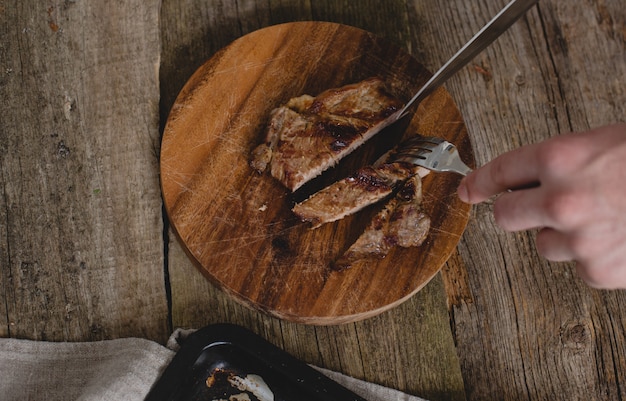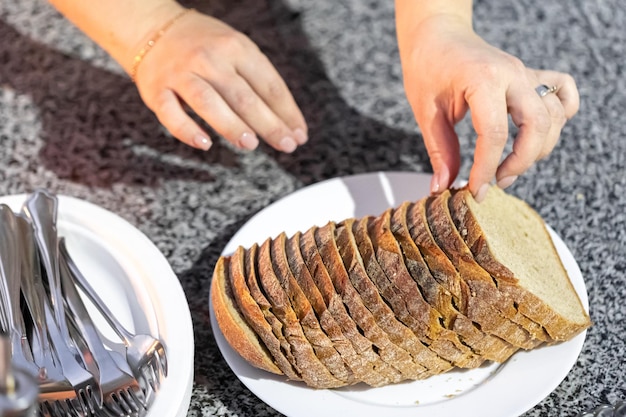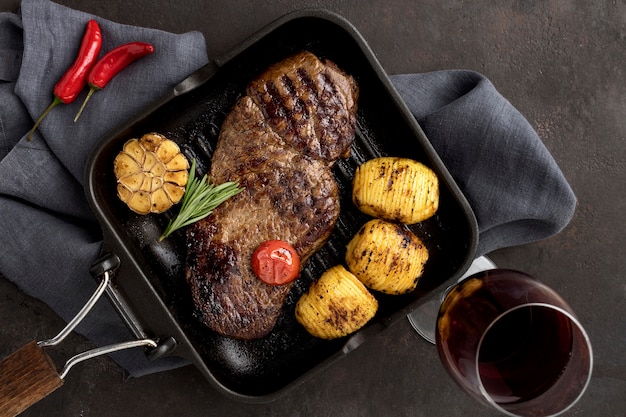The perfect medium-rare steak – juicy, tender, with a hint of pink in the centre and a perfectly seared exterior. It's the ultimate culinary achievement for many steak enthusiasts, myself included. My journey to mastering the medium-rare steak has been a long one, filled with trial and error, but it's taught me so much about the art of cooking a truly delicious steak. Now, I'm ready to share my hard-earned knowledge and guide you through the process, from selecting the right cut to achieving that perfect internal temperature. Get ready to embark on a delicious adventure, because we're diving deep into the world of steak cooking.
Part 1: My Steak Journey: From Charcoal to Perfection

My love affair with steak began in my childhood, helping Dad fire up the barbie on those glorious summer evenings. Back then, it was all about chucking a rump steak on the grill, hoping for the best. More often than not, it ended up dry and charred, leaving a mouthful of charcoal. But those early experiences, despite the lack of finesse, ignited a passion for steak that continues to this day.
Years later, armed with a newfound interest in cooking and a trusty cookbook, I decided to level up my steak game. I started experimenting with different cuts, marinades, and cooking methods. I learned the joy of pan-searing a sirloin, the tenderness of a ribeye, and the rich flavour of a filet mignon. But it wasn't until I discovered the concept of cooking to temperature that I truly felt like I was on the right track.
The Temperature Revelation: A Game Changer
It was a revelation! No more guessing, no more overcooked disasters. With a trusty meat thermometer in hand, I could ensure my steak was cooked to my desired doneness, every single time. It was a game-changer, opening up a whole new world of possibilities. But it wasn't just about the temperature; it was about understanding the factors that contribute to a juicy, flavorful steak.
The Anatomy of a perfect medium-rare steak: A Symphony of Flavour and Texture
Think of a medium-rare steak as a symphony of flavours and textures, a harmonious blend of elements. It's all about finding that perfect balance, a delicate equilibrium. Here's what we're aiming for:
- Juicy Centre: A beautiful, blushing pink centre that melts in your mouth, full of flavour and tenderness.
- Slight Brown Crust: A perfectly seared exterior, a delightful crunch that adds a layer of depth and complexity to the flavour profile.
- Tender Texture: A steak cooked just enough to be tender and succulent, but not so much that it becomes tough and dry.
- Even Cooking: A steak that's cooked evenly throughout, with no cold spots or overcooked areas, ensuring a consistent texture and flavour.
Part 2: Choosing Your Weapon: The steak selection

Now, let's talk about the star of the show: the steak itself. There are countless cuts to choose from, each with its own unique flavour profile and texture, but for the ultimate medium-rare experience, there are a few key contenders that stand out.
The Classic Cuts: The Go-To Options
- Ribeye: This king of steaks boasts beautiful marbling, making it incredibly juicy and flavorful. The marbling, those streaks of fat distributed throughout the meat, creates a buttery, melt-in-your-mouth texture that's simply divine. It's a perfect choice for those who prefer a rich, indulgent steak experience.
- Sirloin: A leaner cut than ribeye, but still incredibly tender and flavorful. While it lacks the marbling of a ribeye, it still offers a fantastic flavour profile, with a slightly firmer texture that some prefer. It's a great option for those who enjoy a more substantial steak.
- Filet Mignon: The most tender cut of all, filet mignon is known for its delicate flavour and buttery texture. This cut comes from the tenderloin, the most tender part of the cow, resulting in a steak that melts in your mouth. It's perfect for those who appreciate a more refined, elegant steak experience.
Beyond the Basics: Stepping Outside the Box
While ribeye, sirloin, and filet mignon are classics for a reason, don't be afraid to venture beyond the usual suspects. There are other cuts out there that offer unique flavour profiles and textures, waiting to be discovered. Here are a few suggestions:
- new york strip: This steak offers a good balance of flavour and tenderness, with a slightly firmer texture than ribeye. It's a great choice for those who prefer a more substantial steak with a hint of chewiness.
- flat iron steak: A relatively new cut, flat iron steak is known for its intense flavour and impressive tenderness. It's an excellent alternative to ribeye, offering a similar level of flavour and tenderness but often at a more affordable price.
- skirt steak: A flavorful and slightly chewy cut, skirt steak is best served thinly sliced. It's a perfect choice for grilling or stir-frying, as its texture allows it to hold up well to high heat.
Part 3: Setting the Stage: Essential Equipment for Steak Success

The right equipment can make all the difference when cooking steak. Here are the essentials you'll need to achieve that perfect medium-rare result.
The Cast Iron King: The Workhorse of Steak Cooking
For me, a cast iron skillet is a must-have for cooking steak. It distributes heat evenly, creating a beautiful crust, and holds its temperature well. It also offers versatility, going straight from the stovetop to the oven, making it perfect for achieving a crispy crust and a perfectly cooked interior.
Temperature Control: The Key to Precision
A good quality meat thermometer is a true game-changer. It allows you to cook your steak to the exact temperature you desire, ensuring consistent results every time. It takes the guesswork out of cooking, allowing you to achieve your desired level of doneness with confidence.
Rest and Relaxation: Allowing the Steak to Breathe
A cutting board and a wire rack are essential for letting your steak rest after cooking. This allows the juices to redistribute throughout the meat, resulting in a more tender and flavorful steak. I like to cover the steak loosely with foil to keep it warm while it rests, ensuring the juices stay locked in and the steak remains at a safe temperature.
Part 4: Preparing for Battle: Prepping for Steak Success
Before you even think about firing up the pan, it's important to prepare your steak properly. A little bit of prep goes a long way in achieving that perfect medium-rare result.
Pat It Dry: A Dry Steak is a Happy Steak
First things first, pat your steak dry with paper towels. This will help to create a nice sear and prevent the steak from steaming instead of browning. A dry surface allows the steak to make direct contact with the hot pan, resulting in a crisp, flavorful crust.
Season with Savour: The Art of Seasoning
Next, season your steak generously with salt and pepper. I like to use kosher salt, as it's larger and less likely to dissolve completely before it has a chance to season the steak. The larger crystals allow for a more even distribution of salt, creating a flavorful crust without being overly salty. Don't be afraid to get adventurous with other seasonings too. Some of my personal favourites include garlic powder, onion powder, smoked paprika, and even a pinch of cayenne pepper for a little kick.
Rest and Relax: Letting the Steak Come Up to Room Temperature
Once your steak is seasoned, let it rest at room temperature for about 30 minutes before cooking. This allows the steak to come up to room temperature, which helps ensure even cooking. A steak that's been sitting in the fridge will be cold in the centre, leading to uneven cooking. Bringing it to room temperature allows it to cook evenly throughout.
Part 5: The Heat is On: Searing and Cooking to Perfection
Now comes the exciting part: cooking the steak! There are a few key things to keep in mind to get that perfect sear and juicy centre.
High Heat Hustle: A Hot Pan is Essential
Start by preheating your cast iron skillet over high heat. You want the pan to be smoking hot before you add the steak. This intense heat will create a beautiful crust and help seal in the juices. If the pan isn't hot enough, the steak will steam instead of sear, resulting in a soggy texture and a lack of flavour.
The Sizzle Test: The Sign of a Hot Pan
Once your pan is hot, add the steak to the skillet and let it sizzle. You should hear a satisfying sizzle as soon as the steak hits the pan. This is a good indication that your pan is hot enough. If you don't hear a sizzle, give the pan a few more minutes to heat up. The sizzle is the sound of the steak's surface proteins reacting to the high heat, forming a crispy crust.
Leave It Be: Don't Flip Too Soon
Resist the urge to flip the steak too soon. Let it cook for about 3-4 minutes on each side, or until a nice crust has formed. This will give you a beautiful sear and help lock in the juices. Flipping too early will prevent the crust from forming, resulting in a steak that's less flavorful and less attractive.
Part 6: The Inner Game: Achieving the Perfect Internal Temperature
While the outer crust is important, it's the inner game that truly determines if your steak is medium-rare perfection. That's where cooking to temperature comes in.
The Thermometer Trick: Precision Cooking
Use your trusty meat thermometer to check the internal temperature of your steak. For medium-rare, you're aiming for an internal temperature of 130-135°F (54-57°C). A meat thermometer is a must-have for any serious steak cook, as it ensures your steak is cooked to your exact specifications, ensuring a consistently juicy and flavorful result.
The Flip Flop: Rest and Rejuvenation
Once the steak has reached the desired internal temperature, remove it from the pan and let it rest for 5-10 minutes. Cover the steak loosely with foil to keep it warm. This is crucial for allowing the juices to redistribute throughout the steak, ensuring a tender and juicy result. The resting period allows the muscle fibres to relax, resulting in a more tender and flavorful steak.
Part 7: The Finishing Touches: Adding Flavour and Finesse
Now that your steak is cooked to perfection, it's time to add those finishing touches that will take it from good to great.
The Sauce Game: Elevating the Steak
While a simple steak doesn't necessarily need a sauce, a good sauce can elevate it to new heights. My personal favourites include a classic béarnaise sauce, a rich and creamy peppercorn sauce, or a simple pan sauce made with butter, garlic, and herbs. A sauce can add a layer of complexity and richness to the flavour profile, complementing the steak beautifully.
The Side Show: Perfecting the Steak Experience
No steak is complete without a delicious side dish. From classic mashed potatoes to roasted vegetables to a light salad, the possibilities are endless. Choose sides that complement the flavour and texture of your steak. Consider the richness of the steak and choose sides that provide a contrast in texture or flavour. For example, a creamy mashed potato pairs well with a rich, buttery ribeye, while a light salad offers a refreshing contrast to a grilled sirloin.
Part 8: The Final Cut: Enjoying the Fruits of Your Labour
Finally, it's time to enjoy the fruits of your labour!
Slice and Dice: The Perfect Cut
Slice your steak against the grain. This will help to make it more tender and easier to chew. Cutting against the grain, meaning perpendicular to the muscle fibres, breaks down the fibres, making the steak more tender and allowing the flavours to be released more easily.
Taste and Enjoy: Savouring the Deliciousness
Take a bite and savour that delicious combination of juicy pink centre, crispy brown crust, and tender texture. That, my friends, is medium-rare perfection. Take your time, savour each bite, and enjoy the satisfaction of knowing you've cooked a truly delicious steak.
FAQs
1. What is the best way to cook a steak?
The best way to cook a steak depends on your personal preference and the cut of meat. However, a cast iron skillet is a great option for achieving a delicious crust and even cooking. It offers excellent heat retention and distribution, resulting in a perfectly cooked steak with a beautiful sear.
2. How long should I cook a steak for medium-rare?
The cooking time for a medium-rare steak will vary depending on the thickness of the steak and the heat of your pan. A general rule of thumb is to cook a 1-inch thick steak for 3-4 minutes per side. Use a meat thermometer to ensure the steak reaches an internal temperature of 130-135°F (54-57°C) for medium-rare. Always rely on a meat thermometer for accurate results, as cooking times can vary depending on factors like the cut of meat and the heat of your pan.
3. Can I cook a steak in the oven?
Yes, you can cook a steak in the oven. Pre-heat your oven to 400°F (200°C). Sear the steak in a skillet for a few minutes on each side, then transfer it to the oven to cook through. The cooking time will vary depending on the thickness of the steak. This method combines the best of both worlds, creating a delicious crust on the stovetop and achieving even cooking in the oven.
4. How long should I let a steak rest after cooking?
It's essential to let a steak rest for 5-10 minutes after cooking. This allows the juices to redistribute, resulting in a more tender and flavorful steak. The resting period allows the muscle fibres to relax, reabsorbing the juices that have been released during cooking, resulting in a more tender and juicy steak.
5. What are some good side dishes for steak?
There are many great side dishes for steak. Some popular options include mashed potatoes, roasted vegetables, asparagus, grilled corn, and salads. Choose sides that complement the flavour and texture of your steak. Consider the richness of the steak and choose sides that provide a contrast in texture or flavour. For example, a creamy mashed potato pairs well with a rich, buttery ribeye, while a light salad offers a refreshing contrast to a grilled sirloin.
Everyone is watching

Perfect Rice Every Time: The Ultimate Guide to Cooking Rice
Cooking TipsAs a self-proclaimed foodie, I've always been a bit obsessed with rice. It's the foundation of countless cuisi...

Prime Rib Roast Cooking Time Chart: Per Pound Guide
Cooking TipsPrime rib roast. Just the name conjures images of lavish dinners, crackling fires, and hearty laughter. It’s ...

The Ultimate Guide to Cooking Asparagus: Tips, Techniques, and Recipes
Cooking TipsAsparagus. The mere mention of this spring delicacy conjures up images of vibrant green spears, crisp and burs...

Ultimate Guide to Cooking the Perfect Thanksgiving Turkey
Cooking TipsThanksgiving. Just the word conjures up images of overflowing tables laden with delicious food, the scent of r...

How Long to Bake Potatoes in the Oven (Perfect Every Time)
Cooking TipsBaked potatoes are a staple in my kitchen. They're incredibly versatile, delicious, and surprisingly easy to m...
